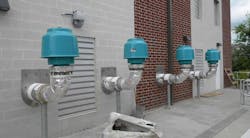A generation ago, wastewater treatment industry constituents—engineers, equipment manufacturers and owners—agreed that positive-seal cartridge-style intake filtration with efficiencies in the 10 µ or smaller range was the most cost-effective way to ensure machine and process reliability. Blower rebuilds and unscheduled outages far outweighed the maintenance costs of filtration.
A few years ago, high-speed turbo blowers (HSTs) were introduced to the aeration blower market, promising 28% to 30% energy savings and almost no mechanical maintenance, thanks to non-contact bearings, lubricant-free machines and few moving parts. However, within a short time, some plants were having trouble keeping their HSTs running reliably enough to realize the new technology’s promise. One issue was inadequate air filtration, because many vendors were using inexpensive tuck-in pad or beverage board HVAC-style intake filters.
A New Approach
Black & Veatch approached the HST blower with an emphasis on intake air filtration. A track record of successful installations, as well as a growing reputation for solving HST reliability issues with upgraded intake air filtration, suggested that HSTs need air at least as free from particulate as traditional technology blowers. Today, HSTs have reinforced this consensus: Blowers must have clean inlet air. The question that remains is finding the best method to filter inlet air.
HST blower enclosures often utilize a louver in the enclosure wall to draw in air from the room, with panel filters mounted behind for both process inlet air and variable-frequency drive and electronic component cooling air. In this configuration, the blower’s impeller provides the draw for both process air and cooling requirements. In fact, up to 30% of the blower’s process air can be drawn through the cooling air filter. The non-contact bearings, electronics and impellers all need clean air to function, so both inlet and cooling filter elements must provide positive seals and adequate efficiencies of at least 98% at 10 µ.
An improved panel filter design, field tested to protect HST blowers, is the disposable, micron-rated, steel-framed, gasketed, pleated element. A media pack is adhesive potted within the steel filter frame on all four sides, preventing casual bypass, and the galvanized steel frame flexes less than 0.02 in. per foot. On the downstream side of the frame is a full-face gasket, renewed every time the filter element is changed, and the improved panel lasts two to three times longer than a pad.
Yet even the best panel filter element is limited by its ability to seal. Because rectangular panel filters must be sealed on four sides, and because the compressive force must be distributed similarly to a flange pattern, providing sufficient force to seal, filter element changes can be onerous or impossible. Therefore, panel filters often are inadequately sealed, utilizing a few latches or springs located sporadically around the outer edge. Worse, when panel filter elements slide into a side-access channel, there is no mechanical means of compressing a gasket, and thus no seal.
A cartridge filter element can eliminate sealing challenges. Properly designed cartridge housings provide thousands of pounds of sealing force by simply hand tightening a single wing-nut or knob. Tri-Vent Series P09 intake filter silencers can reduce blower power consumption, but cartridge filter housings do not readily lend themselves to mounting on the outside of the compact HST blower enclosure. Piping the intake air in from outdoors solves this problem without causing an imbalance in the room ventilation. In addition, outside air is cooler, resulting in better blower efficiency.
Black & Veatch implements the cartridge housing design whenever possible. At the Center Street Wastewater Treatment Plant (WWTP) in Mount Pleasant, S.C., the staff reported that air-foil bearing machines, equipped with Tri-Vent Series cartridge-style intake filter silencers, have reduced overall power consumption by 20% on a dollar-per-million-gal and kilowatt-per-million-gal basis. Plant staff have changed the filters after more than a year since commissioning the blowers. The staff have commented that at the filter intakes, the turbo blowers cannot be heard.
High-speed turbo blowers can hold promise, as evidenced by the following applications.
Pueblo, Colo.
In Pueblo, Colo., the Dilorio Water Reclamation Facility contracted with Black & Veatch to oversee the replacement of its multistage blowers with energy-efficient high-speed turbo blowers. Magnetic bearing machines were chosen, as well as the Endustra Tri-Vent Series KT8 side-access intake filter silencer with Enduralast Hi-Flow Synthetic 98% at 10-μ cartridge filter elements, and an automatically controlled and SCADA-monitored heated inlet to discourage element freeze-up and provide up to 27,000 cu ft per minute of intake air at less than 2 in. water column initial restriction.
Since 2012, the city’s five magnetic-bearing turbo blowers have operated “seamlessly,” and without a single filter freeze, according to superintendent John Lindstrom. Changing the six cartridge filter elements requires a single operator and less than 15 minutes.
Schererville, Ind.
In an effort to reduce energy consumption, the 8.75-million-gal-per-day town of Schererville (Ind.) WWTP installed an air-foil bearing HST in 2011. Outside inlet air was required, so the town purchased a new four-panel industrial-style filter similar to the version that had protected their positive displacement (PD) blowers for decades.
After startup, all of the power savings claims came true. However, after several warranty repairs, it was discovered that on rainy days, water bypassed the inadequate panel element seals and collected in the blower enclosure. The HST manufacturer recommended that Schererville WWTP Superintendent Jim Gorman contact Endustra.
The single-cartridge Tri-Vent Series P09 performed so well that the town replaced the remaining filters on the PD blowers, which now act as standby machines to the HST.
Goldsboro, N.C.
In 2014, Robert “Bert” Sherman, director of the city of Goldsboro (N.C.) WWTP, needed to improve the pad filter on his air-foil bearing HSTs.
“You could see where the dirt was getting around the seal,” Sherman said about the reusable frame, and the pads were lasting between 15 to 30 days, depending on the season.
Endustra provided an improved pleated panel filter element with a rigid steel frame, full-face gasket, and Enduralast Hi-Flow synthetic medium.
The improved filter element lasts between 60 and 90 days, depending on the season, and provides a positive seal.
“The Endustra panel does its job,” Sherman said. “Nothing gets by that filter.”



